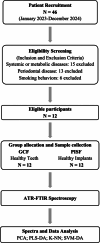Comparative analysis of gingival crevicular fluid and peri-implant crevicular fluid by mid-infrared spectroscopy: a split mouth study
- PMID: 40392311
- PMCID: PMC12092536
- DOI: 10.1007/s00784-025-06382-6
Comparative analysis of gingival crevicular fluid and peri-implant crevicular fluid by mid-infrared spectroscopy: a split mouth study
Abstract
Objectives: This proof-of-concept study aimed to compare the biochemical composition of gingival crevicular fluid (GCF) and peri-implant crevicular fluid (PICF) under healthy conditions, through mid-infrared (MIR) spectroscopy.
Materials and methods: Using a split-mouth design, GCF and PICF samples were collected from 12 participants and analyzed through MIR spectroscopy. Advanced chemometric models, including partial least squares-discriminant analysis, k-nearest neighbors, and support vector machine discriminant analysis, were applied to explore potential biochemical differences between the biofluids.
Results: No cluster formation was observed with PCA, indicating a high degree of similarity between groups. The PLS-DA model didn't effectively discriminate between GCF and PICF with prediction rates of 62.5% (10/16) for calibration, 37.5% (6/16) for cross-validation, and 50% (4/8) for validation. The k-NN model, using k = 3 neighbors showed 25% (4/16) correct classification rates during calibration and a validation set accuracy of 50%. SVM-DA analysis showed a correct prediction rate of 37.5% (6/16) for calibration and 50% for cross-validation 50% (8/16) and 50% (4/8) in the validation phase. Nonetheless, subtle spectral differences were observed in spectral regions R1 (3982-2652 cm⁻1) and R4 (1180-922 cm⁻1), suggesting a slightly increased lipidic content and the presence of ethers and glycosidic bonds linked to carbohydrates, in PICF.
Conclusions: The lack of significant biochemical differences between GCF and PICF under healthy conditions, as determined by MIR spectroscopy, suggests that implant-related changes in PICF composition are negligible.
Clinical relevance: The demonstrated biochemical similarity between GCF and PICF under healthy conditions reinforces the potential of PICF as a reliable biofluid for diagnostic applications, including monitoring oral and systemic health biomarkers, without significant influence from implant-related factors.
Keywords: Chemometric models; Gingival crevicular fluid; Mid-infrared spectroscopy; Peri-implant crevicular fluid.
© 2025. The Author(s).
Conflict of interest statement
Declarations. Ethical approval: All procedures conducted in this research, which included human participants, were in accordance with the ethical guidelines established by the institutional and/or national research committee, as well as the 1964 Helsinki Declaration and its subsequent revisions or equivalent ethical norms. Approval for the trial was granted by the Ethics Committee of the Faculty of Dental Medicine at the University of Porto (FMDUP), with the process number 16/2021. Informed consent: Informed consent was obtained from all individual participants included in the study. Competing interest: The authors declare no competing interests.
Figures




References
-
- Eggert FM, Levin L (2018) Biology of teeth and implants: the external environment, biology of structures, and clinical aspects. Quintessence Int 49:301–312. 10.3290/j.qi.a38544 - PubMed
-
- Zhang F, Liu E, Radaic A, Yu X, Yang S, Yu C, Xiao S, Ye C (2021) Diagnostic potential and future directions of matrix metalloproteinases as biomarkers in gingival crevicular fluid of oral and systemic diseases. Int J Biol Macromol 188:180–196. 10.1016/j.ijbiomac.2021.07.165 - PubMed
-
- Javed F, Al-Hezaimi K, Salameh Z, Almas K, Romanos GE (2011) Proinflammatory cytokines in the crevicular fluid of patients with peri-implantitis. Cytokine 53:8–12. 10.1016/j.cyto.2010.08.013 - PubMed
-
- Ivanovski S, Lee R (2018) Comparison of peri-implant and periodontal marginal soft tissues in health and disease. Periodontol 2000 76:116–130. 10.1111/prd.12150 - PubMed
Publication types
MeSH terms
Substances
Grants and funding
LinkOut - more resources
Full Text Sources

